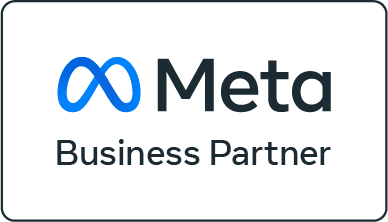For any retail or online store that incorporates digital marketing into their strategy, it’s always important to have a deep understanding of the channels that you will communicate with your audience, and a combined marketing strategy is essential if you want to reach your desired audience.
Combined marketing, also known as multi-channel or omnipresent marketing, can be described as blending a variety of communication channels into one unified strategy with the goal of gaining customers and increasing LTV.
What makes this approach so effective is that it allows brands and performance agencies alike to reach many different audiences simultaneously across multiple channels with the goal of speaking to them on the platform they’re most comfortable with, and likely to purchase from.
In the following blog, we’ll give you an idea of how a combined marketing strategy might look, the benefits, the challenges, and finally why using an agency like Heavy Head Social to implement this strategy may be the right idea for your brand.
Combined Marketing Overview
When people first approach the combined marketing strategy, with the help of an agency or on their way, it’s easy to fall into the trap of just wanting to have a presence on multiple channels such as Facebook, Instagram, TikTok, email and SMS.
While in essence this is the right approach, just being present on these channels is only the beginning of the combined marketing strategy, and a lot of the time many channels end up lying there picking up dust because you’ve bitten off more than you can chew.
The main goal of a combined marketing strategy is to show your current and potential customers that you understand them and want to engage them where they’re comfortable. In reality, it’s easy to forget that everyone is different and responds exactly in that way on different channels.
We have discussed this before, but it really is about personalising the consumer experience and showing them that you understand their wants and needs and are committed to building a long-term relationship with them.
In summary, here’s how a combined marketing strategy might look like:
A person visits your website (and some might even purchase straight off the bat).
However, that same person wants to stay in touch with you for your latest releases, so you set up email marketing that presents them the opportunity to sign up to that constant communication.
Another person is casually thinking about getting a new dress, but couldn’t find what they’re looking for on Google.
Through the magic of media buying, they see one of your ads on Instagram and visit your website.
They make their first purchase, but have no interest in email. However, you’ve got a pop-up for SMS marketing. They’re always on their phone and prefer to just click a link from a short and sweet notification so they sign up to that.
Now, it’s much easier to imagine how without this combined marketing strategy with all the moving parts from different sources but with the same common message, you might have made a sale but lost the opportunity to re-engage and turn this customer into a repeat customer.
This is where combined marketing, at its core, really and truly shines, and why it’s essential for any growing brand, especially in the online marketing space.
Combined Marketing Benefits
Increases amount of data collected
It is probably a phrase that you’ve heard countless times over close to a decade by now, but it’s still worth reminding yourself that data is the new oil.
All of the algorithms and mechanisms that social media and CRM systems are based off wouldn’t be possible without data, and collecting this user data comes in many shapes and forms.
For Facebook, it used to be that you could track people’s movements around the web and understand them so you could re-target them with products that fit their behaviour. After the roll-out of iOS14.5, this isn’t possible, but it makes understanding your users through the collection of other data all the more valuable.
Today, holding first-party data, in the form of email and SMS lists, for example, is important to the success of your brand as that is data about your customers that you own and have collected yourself with their consent.
Data can be collected through surveys, forms, lead magnets in the form of blogs based on pre-determined and always evolving customer avatars, and many more in order to fully understand your customer.
And in order to achieve this, a combined marketing strategy makes it simpler and easier to collect a lot of data so that your messaging for your target audience can be as particular and on point as possible.
Finally, when this data is implemented, people feel a connection to your brand because you understand them on a deeper level and have taken the time to get to know them.
Reach a wider audience
One of the main reasons why a brand would use combined marketing is to reach a wider audience. Today, with so many different mediums and social media platforms, brands want to speak to everyone with the ideal end result being to make more sales.
Combined marketing, by way of Facebook, Instagram, email, SMS, Pinterest, and TikTok, allows brands and agencies to reach a wide range of potential customers in a variety of ways so you’re having these multiple conversations while communicating the same message.
Connect with consumers on their preferred medium
On the back of reaching a wider audience, you’re also going to be communicating with people on their preferred platform.
We discussed what a combined marketing strategy might look like above, and therefore one of the benefits would be because people simply prefer to use email or SMS or Instagram.
While there are platforms that generate more revenue, it’s still relevant that you’re losing out on revenue by not having those conversations with people who may not, for example, spend much time on Facebook but are working online and using their email during the day.
More streams of revenue
As a result, when you’re having these conversations and combining your marketing strategy, you’re also opening yourself up to the possibility of increasing revenue from a number of different sources.
We touched on how people may prefer to be nurtured through email, but if you don’t have email set up on your end, then you’re missing out on opportunities that often offer a higher ROI than, say, Facebook, because it costs less to maintain.
Therefore, if you don’t have a proper combined marketing strategy in place you’re simply missing out on revenue that is there to be gained.
Combined Marketing Challenges
Difficult to manage multiple channels efficiently
One of the biggest challenges of having a combined marketing strategy, especially when you’re doing it on your own, is managing multiple channels efficiently.
This isn’t simply about sending out an email once or twice a week and managing Facebook, but having a cohesive ecosystem in place where each part complements the other and is designed to work in unison.
Often, especially when it comes to smaller brands or online stores that are starting to grow, the people managing the store find that they can only focus on a small number of channels rather than everything all at once, which is where an agency can assist.
Hard to maintain a consistent message and voice
And if you are able to maintain many different marketing channels, the issue may be that you find it hard to remain consistent in your messaging.
For instance, if you’re starting to warm people on Facebook for Black Friday, email and SMS needs to be set up in a way that you’re collecting those leads and also notifying people about the incoming sale.
And not only that, but the ads need to look and sound similar so that everything makes sense.
This issue can also arise if you have two or three different agencies managing different aspects of your business. Having the ecosystem managed by a single agency makes it easier to maintain consistency in the brand message.
Problematic to continuously innovate across all of the channels
What’s more, is that even if you have everything in place, the online space is always innovating and becoming more advanced, and it’s important that brands keep up to date.
We discussed what to expect in 2022 in our last blog, where we focused on advancements in technology such as virtual and augmented reality, but there are even technical aspects such as iOS14.5 that require savvy knowledge of how to communicate with your audience properly or risk not meeting the requirements, thus resulting in a loss of ad spend and marketing revenue.
Combined Marketing with an Agency
It goes without saying that having a combined marketing strategy is essential for any brand or online store, whether you’re established, just starting out, or beginning to grow.
With an agency like Heavy Head Social, we have experts who are well-versed in media buying on Facebook and Instagram, email and SMS marketing, and have the skills to strategise, adapt and overcome any challenges while business owners can focus on the business and take a hands-off approach to their marketing.
You may have opted for the in-house approach, which works too, and we detailed the pros and cons of that here (link), but having an external agency also allows that freedom of not having to micromanage people and deal with endless strategy calls.
We’re adaptable in the sense that we’re happy to take on even one aspect of the marketing side, but throughout this blog we’ve discussed the importance of having a combined strategy that is cohesive and unified, and this is why we feel it is even more beneficial for us to manage everything at once.
Having an agency allows you to focus on the other side of the business, and less about stressing what your Facebook strategy is going to be during February and leading into Black Friday.








